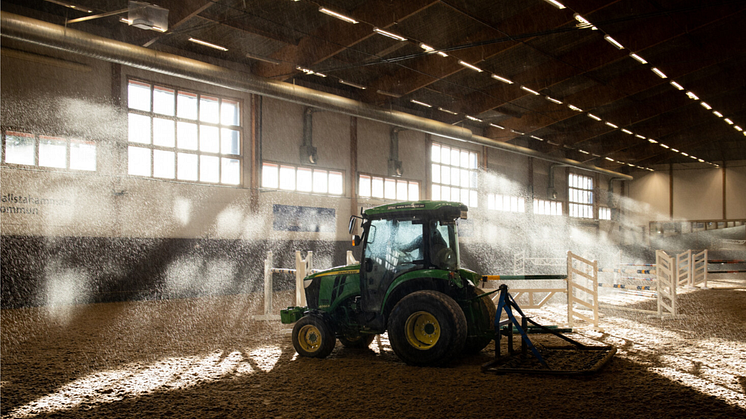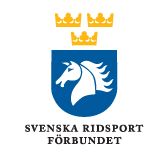
Pressmeddelande -
Pilot Study Initiated by the Swedish Equestrian Federation Throws Light on Microplastics in Equestrian Fibresand Surfaces
The Swedish Equestrian Federation can now present the results of a pilot study on microplastics in equestrian fibresand surfaces in collaboration with Nottingham Trent University, Chalmers University of Technology and the Swedish University of Agricultural Sciences, with a grant from the Swedish Environmental Protection Agency.
Microplastics impact the environment and come from sources including tyre wear, garment washing, industrial pollution, painting, plastic littering and artificial turf. While there is substantial research into artificial turf as a source of microplastic pollution, knowledge on microplastics in fibresand was lacking. The Swedish Equestrian Federation set about to change that, initiating a pilot study in collaboration with scientists at Nottingham Trent University, Chalmers University of Technology and its Sports and Technology initiative as well as the Swedish University of Agricultural Sciences. The interdisciplinary project combined specialists including equestrian surface researchers, veterinarians, a professor in Chemistry and a physicist; Alison Northrop, Jaime Martin, Lars Roepstorff, Cecilia Lönnell, Miia Rihiimäki, Gunnar Westman and Magnus Karlsteen, plus students. The study comes as the EU is set to ban the sales (but not the use) of intentionally added microplastics in sports surfaces in 2031, as part of a wider effort to reduce microplastic pollution.
Fibresand -- where synthetic polymers (“fibre”) is mixed with sand -- has become an increasingly popular choice for equestrian arena surfaces. Of the 1275 arenas the Swedish Equestrian Federation have data on there are 237 fibresand arenas of which 68 are outdoor arenas and 169 indoor arenas [in data covering up to 2022 data].
A study in four parts
This study in four parts aimed to improve the understanding of, and knowledge about, microplastics in equestrian fibresand arenas. For this study the general definition of microplastics being synthetic particles less than 5 millimetres was used. The researchers have been examining the quantities of microplastics in eight fibre raw material samples from three premium producers. As a preliminary study of fragmentation they have also looked at top as well as bottom samples from both the corners and the centre lines of two outdoor and two indoor equestrian arenas to investigate the effects of wear and tear (from e.g. hooves and harrows). In addition, they have studied the water dispersal of microplastics into the environment by collecting drainage water at three outdoor arenas (including a sand-only arena as control). Finally, they examined possible impacts on respiratory health by connecting air pumps with particle filters to riders during dressage lessons at four different riding schools.
Equestrian fibresand arenas included in EU ban despite low levels of microplastics
All four parts of the study showed very low concentrations of microplastics in equestrian fibresand surfaces from the three producers participating in the study. Concentrations were also very low in the air of the indoor and outdoor arenas tested. The results demonstrate that the level of microplastics in fibresand surfaces is a fraction of that in for example artificial turf pitches. The purpose of the fibres is to bind the sand and help support the horse’s hoof, and this is not achieved with the smallest particles. In the samples analysed in this study, particles smaller than 5 millimetres are the result of degradation of larger pieces during production and handling.
– We are so proud to have helped add knowledge on this important topic and we were pleased to see the results. The equestrian world needs to become more sustainable and we required a larger understanding on how this popular surface affects the environment. I would like to direct my heartful gratitude to all of those who have participated with their knowledge and dedication in this first-of-its-kind study, says Andrea Barth, Head of Sports at the Swedish Equestrian Federation.
The new EU restriction taking effect in 2031 covers mixtures with very low concentrations of microplastics, at 0.01 %. It also uses a broader definition of microplastics including threadlike fibres up to 15 millimetres.
– Regardless of definitions and threshold levels, equestrian sports do need to contribute to the reduction of plastics in the environment. Looking ahead there is a need for researching and carefully considering alternative materials ahead of the 2031 ban on sales. We are excited to see what innovations the future will bring, Andrea Barth adds.
The full report is found HERE.
A Q&A is found HERE.
Some key takeaways
Fibresand
- The amount of microplastics (< 5 mm) in raw material samples for fibresand in this study was between 0 and 9.38 %. For a newly installed arena microplastics per square metre fibresand equalled between 0 and 226 g. The corresponding figure for artificial turf is 11.1-14.8 kg per square metre.
- A 20x60 metre equestrian fibresand arena from the producers in this study contain 2.4-6 tonnes of synthetic polymers (“plastics”), out of which 14-272 kilos are microplastics. An artificial turf soccer pitch contains 60-200 tonnes of rubber granules < 5 mm.
- For five products out of eight, the microplastic content translates to between 0.04% and 0.13% per ton. The threshold in the new EU restrictions taking effect in 2031 is 0.01%.
- Four arenas from 2017-2020 contained a mean of 2.5 g of microplastics per kg fibresand.
Water dispersal from fibresand arenas
- The water testing showed low levels of microplastics also in controls without drainage from fibresand, indicating other environmental contamination.
- The highest number of particles in drainage water was 304 in a three-week period. As a comparison one main source of microplastics release in the environment is household washing; for example one fleece garment could release approximately 110,000 microplastic particles in one single wash.
Microplastics in arena air
- In indoor arenas the study found 12 microplastic particles per m3; in outdoor arenas the amount of microplastics was below the measurable threshold value of 4 particles.
- As a comparison, studies of the concentration of microplastics in outdoor air, including major cities, found concentrations between less than 1 to over 1000 microplastic particles per m3, and indoor (homes) between less than 1 and 1583 per m3.
Ämnen
Kategorier
Svenska Ridsportförbundet, Strömsholm, 0220-456 00, www.ridsport.se


